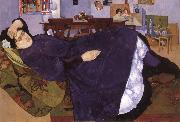Wholesale Oil Painting No Minimum |
|||||||||||
|
|
|||||||||||

|
|||||||||||
|
|
|
||||||||
Max Buri1868-1915,Swiss painter. While still at school he was given drawing lessons by Paul Volmar (1832-1906) in Berne. From 1883 he was a pupil of Fritz Schider (1846-1907) in Basle, where he became acquainted with the works of Hans Holbein the younger and Arnold B?cklin. In 1886 he went to the Akademie der Bildenden K?nste in Munich, transferring in 1887 to Simon Holl?sy painting school. After seeing the works of the French Impressionists exhibited in Munich, he moved to the Acad?mie Julian in Paris in 1889. He made several journeys to Algeria, Holland, Belgium and England, and in 1893 he returned to Munich to study under Albert von Keller. In 1898 he settled in Switzerland, living first at Lucerne, then from 1903 in Brienz, near Interlaken. About 1900, influenced by the paintings of Ferdinand Hodler, Buri moved on from his early genre pictures, which were in mawkish shades of pink in the style of Keller and H?llosy, to achieve an individual style that brought him great popularity. He established his reputation with Village Politicians (1904; Basle, Kstmus.). He painted mainly the landscape and people of the Bernese Oberland, often depicting single figures and groups in front of bare indoor walls in realistic everyday scenes. The expressiveness of the compositions is achieved by clear contours and powerful clearly differentiated surfaces in local colours. Buri works are essentially populist rather than intellectual and avoid Hodler strict parallelism and Symbolist content. |
||||||||
|
|
||||||||
Siesta
Siesta Painting ID:: 50141 |
mk208
1907-1910
mk208 1907-1910 |
|||||||
|
|
||||||||
|
Gustave Courbet 1819-1877 French Gustave Courbet Locations was a French painter whose powerful pictures of peasants and scenes of everyday life established him as the leading figure of the realist movement of the mid-19th century. Gustave Courbet was born at Ornans on June 10, 1819. He appears to have inherited his vigorous temperament from his father, a landowner and prominent personality in the Franche-Comte region. At the age of 18 Gustave went to the College Royal at Besancon. There he openly expressed his dissatisfaction with the traditional classical subjects he was obliged to study, going so far as to lead a revolt among the students. In 1838 he was enrolled as an externe and could simultaneously attend the classes of Charles Flajoulot, director of the ecole des Beaux-Arts. At the college in Besançon, Courbet became fast friends with Max Buchon, whose Essais Poetiques (1839) he illustrated with four lithographs. In 1840 Courbet went to Paris to study law, but he decided to become a painter and spent much time copying in the Louvre. In 1844 his Self-Portrait with Black Dog was exhibited at the Salon. The following year he submitted five pictures; only one, Le Guitarrero, was accepted. After a complete rejection in 1847, the Liberal Jury of 1848 accepted all 10 of his entries, and the critic Champfleury, who was to become Courbet first staunch apologist, highly praised the Walpurgis Night. Siesta mk242 c.1844 16x20cm |
||||||||
|
|
||||||||
|
Prev Next
|
||||||||
|
|
||||||||
|
Related Paintings to Gustave Courbet :. |
||||||||
|
|
||||||||
|
CONTACT US |

